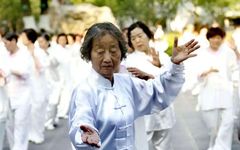1. Tai Chi often does not provide immediate noticeable fitness effects, similar to walking or hiking, but this is not the case. The reasons for this feeling are twofold: First, the practice time is insufficient, meaning the exercise volume is inadequate. If one only practices the simplified Tai Chi three times a day, taking about 15 minutes, it may be suitable for those who are physically weak, but for the average person, this is too short. Generally, one should practice five to seven times, with a practice time of over half an hour. Some advocate for an hour, not including chatting. The appropriateness of exercise volume should be based on self-feeling; one should feel mentally refreshed and physically relaxed after each practice. Second, if one does not strictly follow the principles while practicing, the movements become superficial. Therefore, it is essential to practice Tai Chi seriously and diligently every day to see results.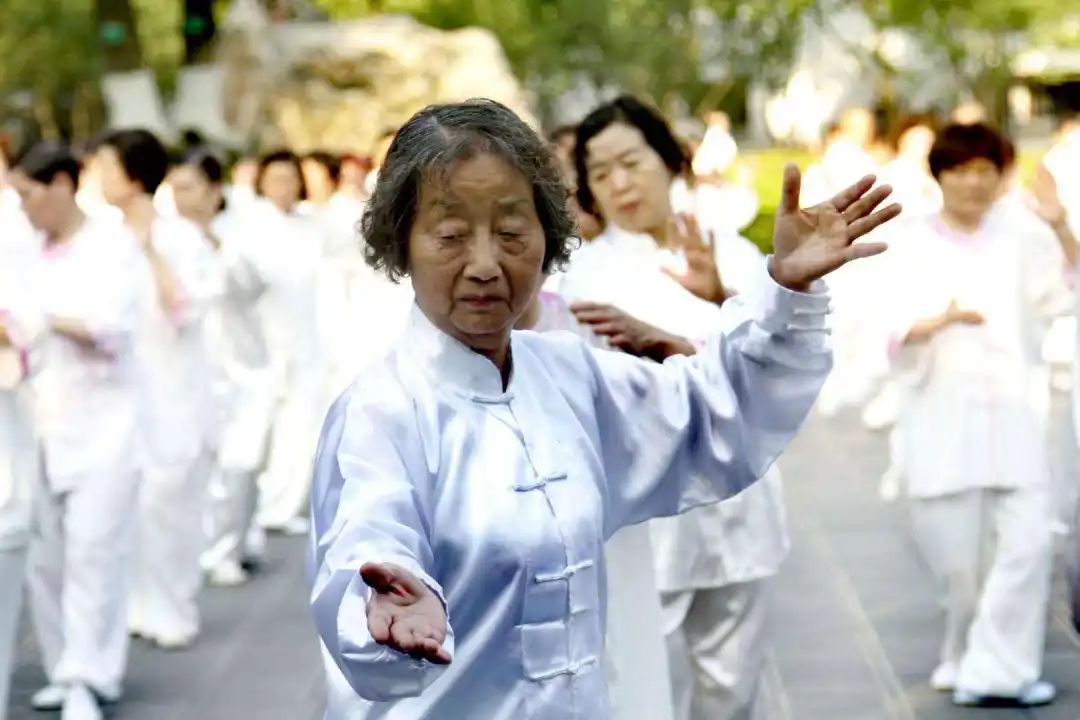 2. What direction should one focus on while practicing? We often learn a set of movements and practice them daily without a clear direction for improvement. The Tai Chi classics mention three stages: familiarity, understanding of energy, and spiritual clarity. Tai Chi emphasizes three stages: practicing the body, practicing Qi (vital energy), and practicing the spirit. Familiarity corresponds to practicing the body, understanding energy corresponds to practicing Qi, and spiritual clarity corresponds to practicing the spirit. Generally, practitioners are between practicing the body and Qi. Practicing the body involves achieving softness and flexibility; practicing Qi involves filling the internal energy. When one achieves internal energy and strength, the maximum fitness effect can be realized. This is our direction of effort: to practice achieving a soft body with a certain level of internal energy and strength. There are many levels to experience within this process. 3. The process of practicing Tai Chi is one of continuous deepening, discovering and correcting mistakes. Generally, one first learns a routine, ensuring the postures are correct (hands, eyes, body, and steps must be as prescribed), then practices lightly, slowly, roundly, and evenly, further achieving coordination, continuity, roundness, and clarity between emptiness and fullness. As one practices, the understanding of the principles and requirements will deepen, and one will continuously discover and correct their mistakes. At this point, one should consciously practice according to the principles, focusing on one aspect of the principles for a period (one to two months) before moving on to the next aspect. 1. 中正安舒 (Zhong Zheng An Shu): Standing upright means the body is naturally straight, achieving a suspended head, tucked tailbone, and aligned shoulders and hips. The alignment of the shoulders and hips means that during movement, the line connecting the two shoulders and the line connecting the two hips must remain in a vertical plane, without twisting. 2. 分清虚实 (Fen Qing Xu Shi): Both advancing and retreating must achieve a gradual transition from empty to full, and vice versa. The center of gravity must change gradually and evenly, reflecting this transition. Each aspect of emptiness and fullness must be continuously transformed. 3. 上下相随 (Shang Xia Xiang Sui): The movements of the hands and feet must coordinate with each other, starting to move simultaneously and reaching the endpoint of each posture together. For example, in the 搂膝拗步式 (Lou Xi Ao Bu Shi), the forward push and downward pull must be synchronized, with the front bow leg moving in unison. The goal is to achieve integrated strength, meaning not just the hands are moving, but the body and legs are moving together. One can first practice individual movements, then pay attention to this coordination within the routine. 4. 用意不用力 (Yong Yi Bu Yong Li): This means using intention more than force; using less force means being light, which is the precursor to relaxation and a bridge to achieving it. If the weight of the hands below the shoulders is 4 pounds, only a minimum force greater than 4 pounds is needed to move the hands, push the body, and the same principle applies to the feet. Learning Tai Chi requires patience and meticulous exploration to practice with minimal force. The content of intention varies at different stages; for example, practicing according to the principles is the content of intention during body practice. Learning Tai Chi mainly relies on the use of imagination. Additionally, understanding the application of each movement helps ensure correct posture during practice, which is not solely about combat.
2. What direction should one focus on while practicing? We often learn a set of movements and practice them daily without a clear direction for improvement. The Tai Chi classics mention three stages: familiarity, understanding of energy, and spiritual clarity. Tai Chi emphasizes three stages: practicing the body, practicing Qi (vital energy), and practicing the spirit. Familiarity corresponds to practicing the body, understanding energy corresponds to practicing Qi, and spiritual clarity corresponds to practicing the spirit. Generally, practitioners are between practicing the body and Qi. Practicing the body involves achieving softness and flexibility; practicing Qi involves filling the internal energy. When one achieves internal energy and strength, the maximum fitness effect can be realized. This is our direction of effort: to practice achieving a soft body with a certain level of internal energy and strength. There are many levels to experience within this process. 3. The process of practicing Tai Chi is one of continuous deepening, discovering and correcting mistakes. Generally, one first learns a routine, ensuring the postures are correct (hands, eyes, body, and steps must be as prescribed), then practices lightly, slowly, roundly, and evenly, further achieving coordination, continuity, roundness, and clarity between emptiness and fullness. As one practices, the understanding of the principles and requirements will deepen, and one will continuously discover and correct their mistakes. At this point, one should consciously practice according to the principles, focusing on one aspect of the principles for a period (one to two months) before moving on to the next aspect. 1. 中正安舒 (Zhong Zheng An Shu): Standing upright means the body is naturally straight, achieving a suspended head, tucked tailbone, and aligned shoulders and hips. The alignment of the shoulders and hips means that during movement, the line connecting the two shoulders and the line connecting the two hips must remain in a vertical plane, without twisting. 2. 分清虚实 (Fen Qing Xu Shi): Both advancing and retreating must achieve a gradual transition from empty to full, and vice versa. The center of gravity must change gradually and evenly, reflecting this transition. Each aspect of emptiness and fullness must be continuously transformed. 3. 上下相随 (Shang Xia Xiang Sui): The movements of the hands and feet must coordinate with each other, starting to move simultaneously and reaching the endpoint of each posture together. For example, in the 搂膝拗步式 (Lou Xi Ao Bu Shi), the forward push and downward pull must be synchronized, with the front bow leg moving in unison. The goal is to achieve integrated strength, meaning not just the hands are moving, but the body and legs are moving together. One can first practice individual movements, then pay attention to this coordination within the routine. 4. 用意不用力 (Yong Yi Bu Yong Li): This means using intention more than force; using less force means being light, which is the precursor to relaxation and a bridge to achieving it. If the weight of the hands below the shoulders is 4 pounds, only a minimum force greater than 4 pounds is needed to move the hands, push the body, and the same principle applies to the feet. Learning Tai Chi requires patience and meticulous exploration to practice with minimal force. The content of intention varies at different stages; for example, practicing according to the principles is the content of intention during body practice. Learning Tai Chi mainly relies on the use of imagination. Additionally, understanding the application of each movement helps ensure correct posture during practice, which is not solely about combat.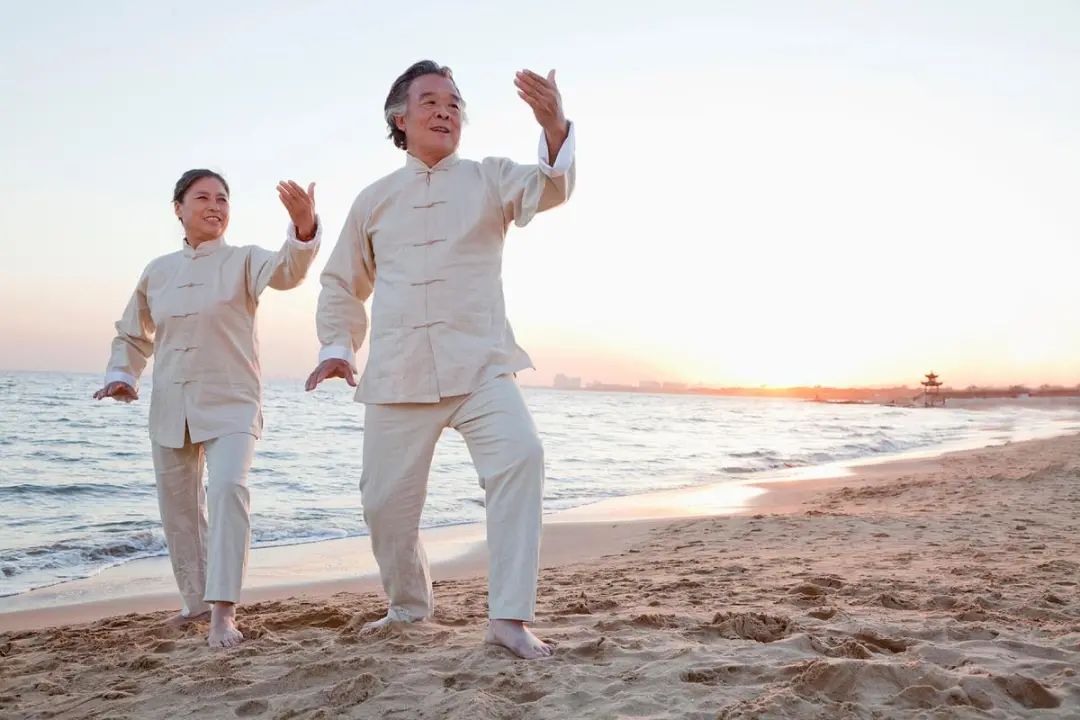 4. Once the movements are correct, one can begin to focus on using the waist. The waist should lead the movements of the limbs. Tai Chi requires the waist to move first, guiding the limbs. The use of the waist can be experienced through movements with a clear arc, such as in the 搂膝拗步 (Lou Xi Ao Bu), practicing the single movement repeatedly to feel how to use the waist. The left and right rotations of the hands are driven by the waist; the hand that pulls the knee moves past the knee due to the waist’s rotation, and the forward push of the hand is the result of the waist leading the hand and body forward. In the 搂膝拗步 (Lou Xi Ao Bu), as the bow stance is formed, the waist rotates and moves forward (the rotation slightly precedes the forward movement, also known as ‘first rotate then advance’). Within a certain distance, the relative position of the hands and body remains unchanged, with the advance slightly preceding the rotation (known as ‘first advance then rotate’). The upper hand achieves its action through the rotation of the waist. In the 揽雀尾 (Lan Que Wei), the squeezing and pressing are achieved by the waist leading the body forward, not just the hands pushing or pressing forward. Once one understands how to use the waist, even the smallest arcs made by the hands are an external manifestation of the waist’s arc. Once one knows how to use the waist, practicing a set of movements means the waist is practicing, not just the hands. One will discover that previous practice was overly artificial, with the limbs being too active and too little passive, failing to move from the inside out. When one knows how to use the waist, the strength is no longer just local strength of the hands. It should also be understood that the rotation of the waist is actually achieved through the rotation of the hips, as the rotation possible through the spine is very limited, and maintaining an upright posture does not allow for spinal twisting. 5. Regarding breathing, beginners can completely ignore it and focus solely on learning the postures. The slow and smooth movements of Tai Chi naturally lead to deeper breathing. After practicing the postures for a certain period, one can consider dedicating time to practice breathing. First, practice breathing while stationary, then adopt a method focusing solely on exhalation. It is important to note that the coordination of movements and breathing should not be overly mechanical, as Tai Chi is not a breathing exercise; some postures can be combined, while those that cannot should not be forced to coordinate. 6. About the flavor and intention of Tai Chi. The intention refers to the unique style of Tai Chi, characterized by relaxation, stability, slowness, and evenness, which represent the essence of Tai Chi. Relaxation includes lightness and softness. Stability involves distinguishing between emptiness and fullness, remaining calm, and not moving chaotically. Slowness benefits silent contemplation and inward reflection, facilitating detailed use of imagination. Only when the movements are even can one achieve a static state; when the entire body is coordinated evenly, one can achieve complete strength. To practice Tai Chi with its essence, one must ensure the body is relaxed, distinguish between emptiness and fullness, coordinate movements, harmonize internal and external, and breathe smoothly. 7. Relaxation in Tai Chi requires both softness and release in the limbs. Softness refers to the flexibility and high mobility of the limbs, especially the joints. Release means allowing each joint to extend comfortably in a natural manner. We pursue a clever combination of softness and release. Relaxation runs through all stages of Tai Chi. Softness is the soul of Tai Chi, and practicing Tai Chi is a continuous effort to pursue a higher level of softness. The relaxation required in Tai Chi is achieved through the action of thought and awareness, gradually reaching the maximum softness with minimal effort, moving from lightness to relaxation.
4. Once the movements are correct, one can begin to focus on using the waist. The waist should lead the movements of the limbs. Tai Chi requires the waist to move first, guiding the limbs. The use of the waist can be experienced through movements with a clear arc, such as in the 搂膝拗步 (Lou Xi Ao Bu), practicing the single movement repeatedly to feel how to use the waist. The left and right rotations of the hands are driven by the waist; the hand that pulls the knee moves past the knee due to the waist’s rotation, and the forward push of the hand is the result of the waist leading the hand and body forward. In the 搂膝拗步 (Lou Xi Ao Bu), as the bow stance is formed, the waist rotates and moves forward (the rotation slightly precedes the forward movement, also known as ‘first rotate then advance’). Within a certain distance, the relative position of the hands and body remains unchanged, with the advance slightly preceding the rotation (known as ‘first advance then rotate’). The upper hand achieves its action through the rotation of the waist. In the 揽雀尾 (Lan Que Wei), the squeezing and pressing are achieved by the waist leading the body forward, not just the hands pushing or pressing forward. Once one understands how to use the waist, even the smallest arcs made by the hands are an external manifestation of the waist’s arc. Once one knows how to use the waist, practicing a set of movements means the waist is practicing, not just the hands. One will discover that previous practice was overly artificial, with the limbs being too active and too little passive, failing to move from the inside out. When one knows how to use the waist, the strength is no longer just local strength of the hands. It should also be understood that the rotation of the waist is actually achieved through the rotation of the hips, as the rotation possible through the spine is very limited, and maintaining an upright posture does not allow for spinal twisting. 5. Regarding breathing, beginners can completely ignore it and focus solely on learning the postures. The slow and smooth movements of Tai Chi naturally lead to deeper breathing. After practicing the postures for a certain period, one can consider dedicating time to practice breathing. First, practice breathing while stationary, then adopt a method focusing solely on exhalation. It is important to note that the coordination of movements and breathing should not be overly mechanical, as Tai Chi is not a breathing exercise; some postures can be combined, while those that cannot should not be forced to coordinate. 6. About the flavor and intention of Tai Chi. The intention refers to the unique style of Tai Chi, characterized by relaxation, stability, slowness, and evenness, which represent the essence of Tai Chi. Relaxation includes lightness and softness. Stability involves distinguishing between emptiness and fullness, remaining calm, and not moving chaotically. Slowness benefits silent contemplation and inward reflection, facilitating detailed use of imagination. Only when the movements are even can one achieve a static state; when the entire body is coordinated evenly, one can achieve complete strength. To practice Tai Chi with its essence, one must ensure the body is relaxed, distinguish between emptiness and fullness, coordinate movements, harmonize internal and external, and breathe smoothly. 7. Relaxation in Tai Chi requires both softness and release in the limbs. Softness refers to the flexibility and high mobility of the limbs, especially the joints. Release means allowing each joint to extend comfortably in a natural manner. We pursue a clever combination of softness and release. Relaxation runs through all stages of Tai Chi. Softness is the soul of Tai Chi, and practicing Tai Chi is a continuous effort to pursue a higher level of softness. The relaxation required in Tai Chi is achieved through the action of thought and awareness, gradually reaching the maximum softness with minimal effort, moving from lightness to relaxation.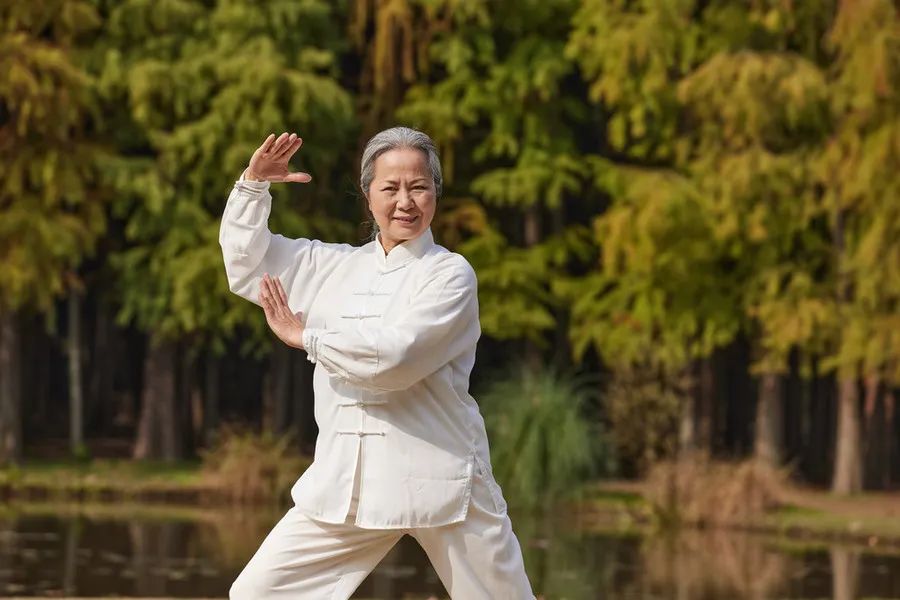 1. At the beginning of practice, first relax the entire body, especially the arms, which should feel as if they are loosely tied to the shoulders, without any tension. Once the body and mind are calm, then begin the movements. Relaxing the shoulders means imagining the shoulder joints loosening. 2. The softness in the feet is greatly related to whether one can open the stance and sink the energy. If during practice, the steps are larger, one must focus on sinking energy; each movement should have both rising and sinking, allowing the feet to achieve considerable softness. The feet should be trained to feel like two highly elastic springs, capable of moving freely and flexibly. 3. The key to relaxing the waist is to slightly retract the area around the navel (pulling back, not pressing down or lifting up) while the Mingmen (命门穴, Mingmen point) is relaxed and slightly pushed back (pulled). This action is habitually referred to as ‘pulling the waist,’ but it is actually the key to relaxing the waist. 4. The hips are relatively difficult to relax, so one can practice relaxing the waist and activating the hips. With the toes gripping the ground and the heels stable, the upper body remains naturally upright, and the waist and hips are completely relaxed. Using the hip joints as the axis, move back and forth in a figure-eight pattern, and then similarly move the knee and ankle joints in circles. One can also practice rotating the hips around the knees. 8. Once relaxed, the entire body will feel heavy (this is a natural heaviness, not forced), and the slight movements will feel as if they are interacting with the air like movements in water. The longer one practices, the more relaxed one becomes, and the heavier the body feels, while also feeling increased air resistance, which enhances sensitivity. Internal strength is primarily sought through practicing the postures, allowing the shoulders to sink and elbows to drop, aiming to experience the weight of the arms; sinking Qi to the Dantian (丹田) and relaxing the waist to experience the weight of the upper body; stepping lightly like a cat, ensuring that both legs feel the weight during the transitions between emptiness and fullness. The day one feels the load of the body’s weight is the day one experiences the internal strength of Tai Chi. Practicing internal strength generally starts from the hands, allowing the hands to experience their own weight, and then gradually expanding this experience to other parts of the body. Internal Qi is a subtle sense of self-awareness. With a calm mind, the entire body relaxed, and practicing slowly with intention rather than force, over time, the hands will feel a swelling warmth, transitioning from occasional to frequent during practice. 9. Further practice involves sinking the strength to the soles of the feet. The specific practice method: all movements of the hips, whether advancing, retreating, or moving sideways, must utilize the grounding force of the feet and the reactive force of the feet pressing against the ground. This way, the strength from the soles drives the hips, and the hips drive the movements of the entire body. The longer one practices, the more relaxed and agile the body becomes, with all strength emanating from the feet acting on the ground. At this stage, one has managed to sink the strength to the soles of the feet. The Tai Chi classics state, ‘Strength arises from the feet’ and ‘is governed by the waist,’ which conveys this meaning. The waist refers not only to the Mingmen point but also to the two hips.
1. At the beginning of practice, first relax the entire body, especially the arms, which should feel as if they are loosely tied to the shoulders, without any tension. Once the body and mind are calm, then begin the movements. Relaxing the shoulders means imagining the shoulder joints loosening. 2. The softness in the feet is greatly related to whether one can open the stance and sink the energy. If during practice, the steps are larger, one must focus on sinking energy; each movement should have both rising and sinking, allowing the feet to achieve considerable softness. The feet should be trained to feel like two highly elastic springs, capable of moving freely and flexibly. 3. The key to relaxing the waist is to slightly retract the area around the navel (pulling back, not pressing down or lifting up) while the Mingmen (命门穴, Mingmen point) is relaxed and slightly pushed back (pulled). This action is habitually referred to as ‘pulling the waist,’ but it is actually the key to relaxing the waist. 4. The hips are relatively difficult to relax, so one can practice relaxing the waist and activating the hips. With the toes gripping the ground and the heels stable, the upper body remains naturally upright, and the waist and hips are completely relaxed. Using the hip joints as the axis, move back and forth in a figure-eight pattern, and then similarly move the knee and ankle joints in circles. One can also practice rotating the hips around the knees. 8. Once relaxed, the entire body will feel heavy (this is a natural heaviness, not forced), and the slight movements will feel as if they are interacting with the air like movements in water. The longer one practices, the more relaxed one becomes, and the heavier the body feels, while also feeling increased air resistance, which enhances sensitivity. Internal strength is primarily sought through practicing the postures, allowing the shoulders to sink and elbows to drop, aiming to experience the weight of the arms; sinking Qi to the Dantian (丹田) and relaxing the waist to experience the weight of the upper body; stepping lightly like a cat, ensuring that both legs feel the weight during the transitions between emptiness and fullness. The day one feels the load of the body’s weight is the day one experiences the internal strength of Tai Chi. Practicing internal strength generally starts from the hands, allowing the hands to experience their own weight, and then gradually expanding this experience to other parts of the body. Internal Qi is a subtle sense of self-awareness. With a calm mind, the entire body relaxed, and practicing slowly with intention rather than force, over time, the hands will feel a swelling warmth, transitioning from occasional to frequent during practice. 9. Further practice involves sinking the strength to the soles of the feet. The specific practice method: all movements of the hips, whether advancing, retreating, or moving sideways, must utilize the grounding force of the feet and the reactive force of the feet pressing against the ground. This way, the strength from the soles drives the hips, and the hips drive the movements of the entire body. The longer one practices, the more relaxed and agile the body becomes, with all strength emanating from the feet acting on the ground. At this stage, one has managed to sink the strength to the soles of the feet. The Tai Chi classics state, ‘Strength arises from the feet’ and ‘is governed by the waist,’ which conveys this meaning. The waist refers not only to the Mingmen point but also to the two hips.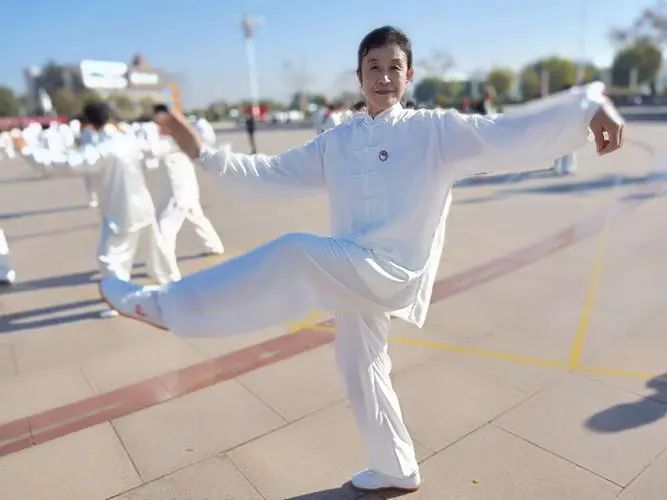 10. Further practice involves issuing strength. Each time the posture is established, in a state of seeming stillness yet not stillness, one must sink into the internal strength. This practice of internal strength is the reason for the generation of internal strength in Tai Chi. How to practice this internal strength: whenever in a fixed posture, such as during the squeezing or pressing movements, one must sink the shoulders and drop the elbows, maintain a sense of lifting the head, push the tailbone forward, and relax the Mingmen point (命门穴, Mingmen point) while pulling back. The palms should move slowly forward, and the upper body should slightly lean back. The joints and ligaments should be relaxed, forming a bow-like structure in the hands, legs, and body, with the gaze directed forward, as if extending the strength to the horizon; ‘the further the intention, the longer the strength.’ This should be the case for every fixed posture during practice. At this point, the hands do not feel like they are exerting force. However, if there is an obstruction in front of the hands, the person will feel a significant force; this is the manifestation of hidden strength, not visible strength. Using intention as guidance, each movement should initiate strength from the heels (reactive force), directing the internal strength through the waist to the spine, shoulders, elbows, wrists, and fingers. Over time, the target area will feel a tingling sensation, and the hands (劳宫穴, Lao Gong point) will feel a pulsing sensation. In summary, completing a set of Tai Chi does not mean one can practice independently; it does not mean one has truly learned it. Tai Chi emphasizes not only form but also content, which is abundant. Only with content can one have the flavor of Tai Chi; at this point, one can be considered to have a basic understanding. Continuous pursuit is necessary to deepen the flavor of Tai Chi. If the flavor is not right, it remains an empty form, and practicing it will not yield significant progress. Consistent practice, regardless of the season, will certainly lead to health, although the degree of effectiveness may vary. After persistent practice, the circulation of Qi and blood in the body normalizes, resulting in a sense of lightness and comfort, leading to better health, which is the ultimate goal.Source: Internet. If there is any infringement, please contact for removal.If you like this article, remember toshare and give a thumbs up belowto let us know!
10. Further practice involves issuing strength. Each time the posture is established, in a state of seeming stillness yet not stillness, one must sink into the internal strength. This practice of internal strength is the reason for the generation of internal strength in Tai Chi. How to practice this internal strength: whenever in a fixed posture, such as during the squeezing or pressing movements, one must sink the shoulders and drop the elbows, maintain a sense of lifting the head, push the tailbone forward, and relax the Mingmen point (命门穴, Mingmen point) while pulling back. The palms should move slowly forward, and the upper body should slightly lean back. The joints and ligaments should be relaxed, forming a bow-like structure in the hands, legs, and body, with the gaze directed forward, as if extending the strength to the horizon; ‘the further the intention, the longer the strength.’ This should be the case for every fixed posture during practice. At this point, the hands do not feel like they are exerting force. However, if there is an obstruction in front of the hands, the person will feel a significant force; this is the manifestation of hidden strength, not visible strength. Using intention as guidance, each movement should initiate strength from the heels (reactive force), directing the internal strength through the waist to the spine, shoulders, elbows, wrists, and fingers. Over time, the target area will feel a tingling sensation, and the hands (劳宫穴, Lao Gong point) will feel a pulsing sensation. In summary, completing a set of Tai Chi does not mean one can practice independently; it does not mean one has truly learned it. Tai Chi emphasizes not only form but also content, which is abundant. Only with content can one have the flavor of Tai Chi; at this point, one can be considered to have a basic understanding. Continuous pursuit is necessary to deepen the flavor of Tai Chi. If the flavor is not right, it remains an empty form, and practicing it will not yield significant progress. Consistent practice, regardless of the season, will certainly lead to health, although the degree of effectiveness may vary. After persistent practice, the circulation of Qi and blood in the body normalizes, resulting in a sense of lightness and comfort, leading to better health, which is the ultimate goal.Source: Internet. If there is any infringement, please contact for removal.If you like this article, remember toshare and give a thumbs up belowto let us know!
